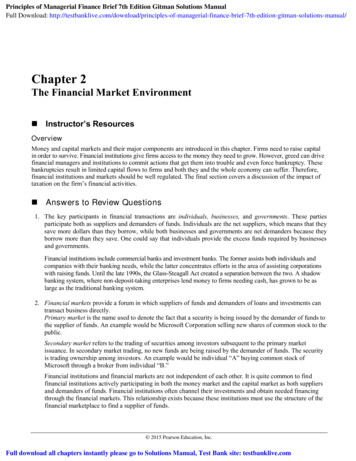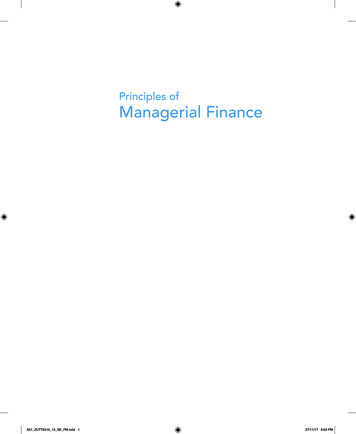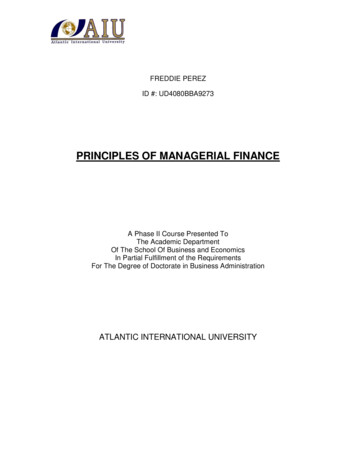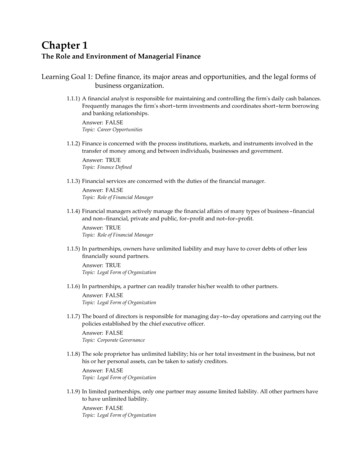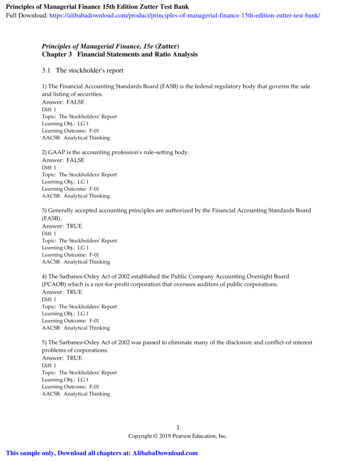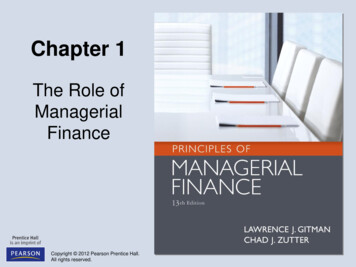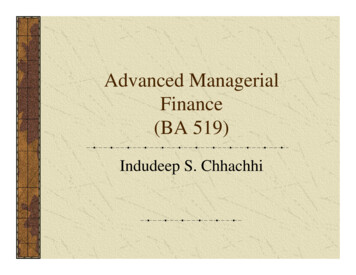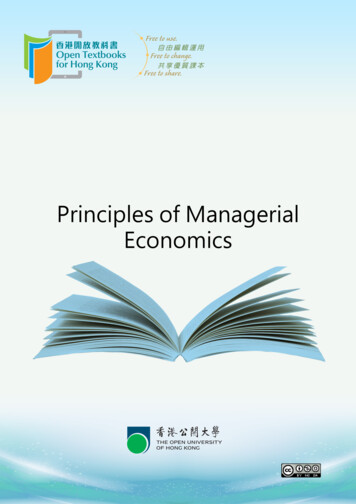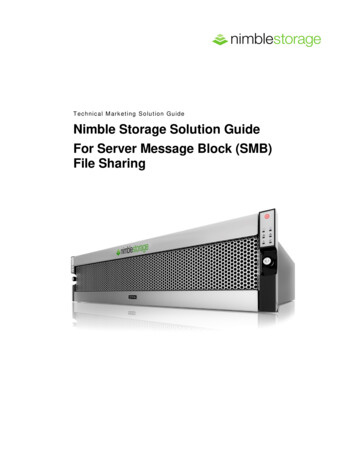
Transcription
Principles of Managerial Finance SolutionLawrence J. GitmanCHAPTER 3Cash Flow and Financial PlanningINSTRUCTOR’S RESOURCESOverviewThis chapter introduces the student to the financial planning process, with the emphasis on short-term (operating)financial planning and its two key components: cash planning and profit planning. Cash planning requirespreparation of the cash budget, while profit planning involves preparation of a pro forma income statement andbalance sheet. The text illustrates through example how these budgets and statements are developed. Theweaknesses of the simplified approaches (judgmental and percent-of-sales methods) of pro forma statementpreparation are outlined. The distinction between Operating cash flow and Free cash flow is presented anddiscussed. Current tax law regarding the depreciation of assets and the effect on cash flow are also described.The firm's cash flow is analyzed through classification of sources and uses of cash. The student is guided in astep-by-step preparation of the statement of cash flows and the interpretation of this statement.PMF DISKThis chapter's topics are not covered on the PMF Tutor, PMF Problem-Solver, or the PMF Templates.Study GuideSuggested Study Guide examples for classroom presentation:Example13TopicCash budgetsPro forma financial statementsFind out more at www.kawsarbd1.weebly.com47Last saved and edited by Md.Kawsar Siddiqui
Chapter 3 Cash Flow and Financial PlanningANSWERS TO REVIEW QUESTIONS3-1The first four classes of property specified by the MACRS system are categorized by the length of thedepreciation (recovery) period are called 3-, 5-, 7-, and 10-year property:RecoveryPeriod3 years5 years7 years10 yearsDefinitionResearch and experiment equipment and certain special tools.Computers, typewriters, copiers, duplicating equipment, cars, light duty trucks, qualifiedtechnological equipment, and similar assets.Office furniture, fixtures, most manufacturing equipment, railroad track, and single-purposeagricultural and horticultural structures.Equipment used in petroleum refining or in the manufacture of tobacco products and certainfood products.The depreciation percentages are determined by the double-declining balance (200%) method using thehalf-year convention and switching to straight-line depreciation when advantageous.3-2Operating flows relate to the firm's production cycle from the purchase of raw materials to the finishedproduct. Any expenses incurred directly related to this process are considered operating flows.Investment flows result from the purchases and sales of fixed assets and business interests.Financing flows result from borrowing and repayment of debt obligations and from equity transactionssuch as the sale or purchase of stock and dividend payments.3-3A decrease in the cash balance is a source of cash flow because cash flow must have been released forsome purpose, such as an increase in inventory. Similarly, an increase in the cash balance is a use of cashflow, since the cash must have been drawn from some source of cash flow. The increase in cash is aninvestment (use) of cash in an asset.3-4Depreciation (and amortization and depletion) is a cash inflow to the firm since it is treated as a non-cashexpenditure from the income statement. This reduces the firm's cash outflows for tax purposes. Cash flowfrom operations can be found by adding depreciation and other non-cash charges back to profits aftertaxes. Since depreciation is deducted for tax purposes but does not actually require any cash outlay, itmust be added back in order to get a true picture of operating cash flows.3-5Cash flows shown in the statement of cash flows are divided into three categories and presented in theorder of: 1. cash flow from operations, 2. cash flow from investments, and 3. cash flow from financing.Traditionally cash outflows are shown in brackets to distinguish them from cash inflows.3-6Operating cash flow is the cash flow generated from a firm’s normal operations of producing and sellingits output of goods and services. Free cash flow is the amount of cash flow available to both debt andequity investors after the firm has met its operating and asset investment needs.3-7The financial planning process is the development of long-term strategic financial plans that guide thepreparation of short-term operating plans and budgets. Long-term (strategic) financial plans anticipate thefinancial impact of planned long-term actions (periods ranging from two to ten years). Short-termFind out more at www.kawsarbd1.weebly.com48Last saved and edited by Md.Kawsar Siddiqui
Chapter 3 Cash Flow and Financial Planning(operating) financial plans anticipate the financial impact of short-term actions (periods generally less thantwo years).3-8Three key statements resulting from short-term financial planning are 1) the cash budget, 2) the pro formaincome statement, and 3) the pro forma balance sheet.3-9The cash budget is a statement of the firm's planned cash inflows and outflows. It is used to estimate itsshort-term cash requirements. The sales forecast is the key variable in preparation of the cash budget.Significant effort should be expended in deriving a sales figure.3-10The basic format of the cash budget is presented in the table below.Cash receiptsLess: Cash disbursementsNet cash flowAdd: Beginning cashEnding cashLess: Minimum cash balanceRequired total financing(Notes payable)Excess cash balance(Marketable securities)Cash Budget FormatJan.Feb. xx xxxxxxxxxxxxxxxxxxxxxx xx Nov. xxxxxxxxxxxxDec. xxxxxxxxxxxx xxThe components of the cash budget are defined as follows:Cash receipts - the total of all items from which cash inflows result in any given month. The mostcommon components of cash receipts are cash sales, collections of accounts receivable, and other cashreceived from sources other than sales (dividends and interest received, asset sales, etc.).Cash disbursements - all outlays of cash in the periods covered. The most common cash disbursements arecash purchases, payments of accounts payable, payments of cash dividends, rent and lease payments,wages and salaries, tax payments, fixed asset outlays, interest payments, principal payments (loans), andrepurchases or retirement of stock.Net cash flow - found by subtracting the cash disbursements from cash receipts in each month.Ending cash - the sum of beginning cash and net cash flow.Required total financing - the result of subtracting the minimum cash balance from ending cash andobtaining a negative balance. Usually financed with notes payable.Excess cash - the result of subtracting the minimum cash balance from ending cash and obtaining apositive balance. Usually invested in marketable securities.Find out more at www.kawsarbd1.weebly.com49Last saved and edited by Md.Kawsar Siddiqui
Chapter 3 Cash Flow and Financial Planning3-11The ending cash without financing, along with any required minimum cash balance, can be used todetermine if additional cash is needed or excess cash will result. If the ending cash is less than theminimum cash balance, additional financing must be arranged; if the ending cash is greater than theminimum cash balance, investment of the surplus should be planned.3-12Uncertainty in the cash budget is due to the uncertainty of ending cash values, which are based onforecasted values. This may cause a manager to request or arrange to borrow more than the maximumfinancing indicated. One technique used to cope with this uncertainty is sensitivity analysis. This involvespreparing several cash budgets, based on different assumptions: a pessimistic forecast, a most likelyforecast, and an optimistic forecast. A more sophisticated technique is to use computer simulation.3-13Pro forma statements are used to provide a basis for analyzing future profitability and overall financialperformance as well as predict external financing requirements. The sales forecast is the first statementprepared, since projected sales figures are the driving force behind the development of all other statements.The firm's latest actual balance sheet and income statement are needed as the base year for preparing proforma statements.3-14In the percent-of-sales method for preparing a pro forma income statement, the financial manager beginswith sales forecasts and uses values for cost of goods sold, operating expenses, and interest expense thatare expressed as a percentage of projected sales. This technique assumes all costs to be variable. Theweakness of this approach is that net profit may be overstated for firms with high fixed costs andunderstated for firms with low fixed costs. The strength of this approach is ease of calculation.3-15Due to the effect of leverage, ignoring fixed costs tends to understate profits when sales are rising andoverstate them when sales are falling. To avoid this problem, the analyst should divide the expense portionof the pro forma income statement into fixed and variable components.3-16The judgmental approach is used to develop the pro forma balance sheet by estimating some balance sheetaccounts while calculating others. This method assumes that values of variables such as cash, accountsreceivable, and inventory can be forced to take on certain values rather than occur as a natural flow ofbusiness transactions.3-17The balancing, or "plug," figure used in the pro forma balance sheet prepared with the judgmentalapproach is the amount of financing necessary to bring this statement into balance. Sometimes an analystwishing to estimate a firm's long-term borrowing requirement will forecast the balance sheet and let this"plug" figure represent the firm's estimated external funds required.A positive external funds required figure means the firm must raise funds externally to meet its operatingneeds. Once it determines whether to use debt or equity, its pro forma balance sheet can be adjusted toreflect the planned financing strategy. If the figure is negative, the firm's forecast shows that its financingis greater than its requirements. Surplus funds can be used to repay debt, repurchase stock, or increasedividends. The pro forma balance sheet would be modified to show the planned changes.3-18Simplified approaches to preparing pro forma statements have two basic weaknesses: 1) the assumptionthat the firm's past financial condition is an accurate predictor of its future and 2) the assumption that thevalues of certain variables can be forced to take on desired values. The approaches remain popular due toease of calculation.Find out more at www.kawsarbd1.weebly.com50Last saved and edited by Md.Kawsar Siddiqui
Chapter 3 Cash Flow and Financial Planning3-19The financial manager may perform ratio analysis and may possibly prepare source and use statementsfrom pro forma statements. He treats the pro forma statements as if they were actual statements in order toevaluate various aspects of the firm's financial health liquidity, activity, debt, and profitability expectedat the end of the future period. The resulting information is used to adjust planned operations to achieveshort-term financial goals. Of course, the manager reviews and may question various assumptions andvalues used in forecasting these statements.Find out more at www.kawsarbd1.weebly.com51Last saved and edited by Md.Kawsar Siddiqui
Chapter 3 Cash Flow and Financial PlanningSOLUTIONS TO PROBLEMS3-1LG 1: DepreciationYearAsset A1234YearAsset B1234563-2Depreciation SchedulePercentagesCostfrom Table 3.2(1)(2) 17,000 17,000 17,000 17,000Depreciation[(1) x (2)](3)33%45157 5,6107,6502,5501,190Depreciation SchedulePercentagesCostfrom Table 3.2(1)(2) 45,000 45,000 45,000 45,000 45,000 45,000Depreciation[(1) x (2)](3)20%321912125 9,00014,4008,5505,4005,4002,250LG 2: Accounting Cash flowEarnings after taxesPlus: DepreciationPlus: AmortizationCash flow from operations 50,00028,0002,000 80,0003-3LG 1, 2: MACRS Depreciation Expense, Taxes, and Cash Flowa.From table 3.2Depreciation expense 80,000 x .20 16,000b.New taxable income 430,000 - 16,000 414,000Tax liability 113,900 [( 414,000 - 335,000) x .34] 113,900 26,860 140,760Original tax liability before depreciation expense:Tax liability 113,900 [( 430,000 - 335,000) x .34] 113,900 32,300 146,200Find out more at www.kawsarbd1.weebly.com52Last saved and edited by Md.Kawsar Siddiqui
Chapter 3 Cash Flow and Financial PlanningTax savings 146,200 - 140,760 5,440c.After-tax net incomePlus depreciation expenseNet cash flow 289,240 ( 430,000 - 140,760)16,000 305,2403-4LG 1, 2: Depreciation and Accounting Cash Flowa.Cash flow from operations:Sales revenueLess: Total costs before depreciation,interest, and taxesDepreciation expenseInterest expenseNet profits before taxesLess: Taxes at 40%Net profits after taxesPlus: DepreciationCash flow from operations 400,000290,00034,20015,000 60,80024,320 36,48034,200 70,680b.Depreciation and other no cash charges serve as a tax shield against income, increasing annual cash flow.3-5LG 2: Classifying Inflows and Outflows of CashChangeItem( )Cash 100Accounts payable -1,000Notes payable 500Long-term debt-2,000Inventory 200Fixed assets 400I/OOOIOOOChangeItem( )Accounts receivable -700Net profits 600Depreciation 100Repurchase of stock 600Cash dividends 800Sale of stock 1,0003-6LG 2: Finding Operating and Free Cash Flowsa.Cash flow from operations Net profits after taxes DepreciationCash flow from operations 1,400 11,600Cash flow from operations 13,000b.OCF EBIT – Taxes DepreciationOCF 2,700 – 933 11,600OCF 13,367c.FCF OCF – Net fixed asset investment* – Net current asset investment**FCF 13,367 - 1,400 - 1,400FCF 10,567I/OIIIOOI* Net fixed asset investment Change in net fixed assets DepreciationNet fixed asset investment ( 14,800 - 15,000) ( 14,700 - 13,100)Find out more at www.kawsarbd1.weebly.com53Last saved and edited by Md.Kawsar Siddiqui
Chapter 3 Cash Flow and Financial Plan
Principles of Managerial Finance Solution Lawrence J. Gitman Find out more at www.kawsarbd1.weebly.com 47 Last saved and edited by Md.Kawsar Siddiqui CHAPTER 3 Cash Flow and Financial Planning INSTRUCTOR’S RESOURCES Overview This chapter introduces the student to the financial planning process, with the emphasis on short-term (operating) financial planning and its
